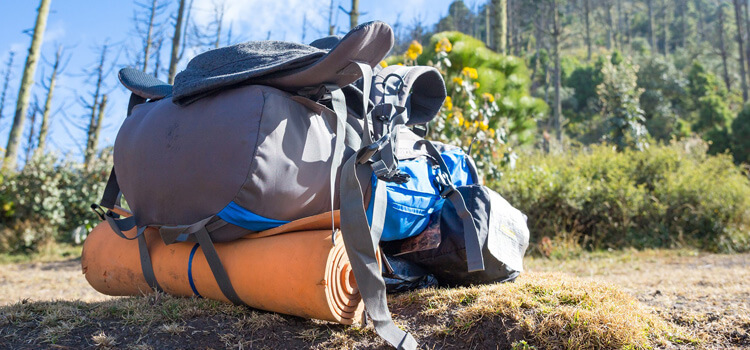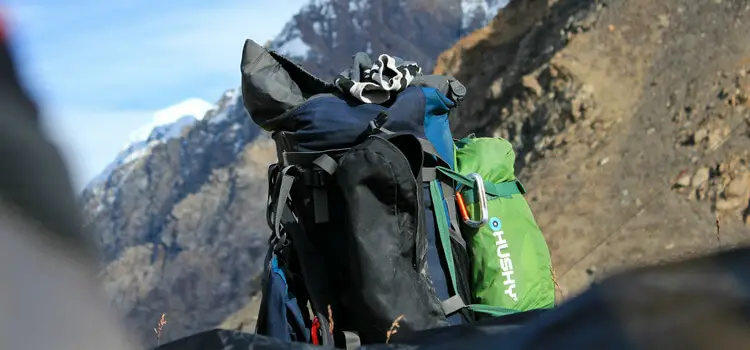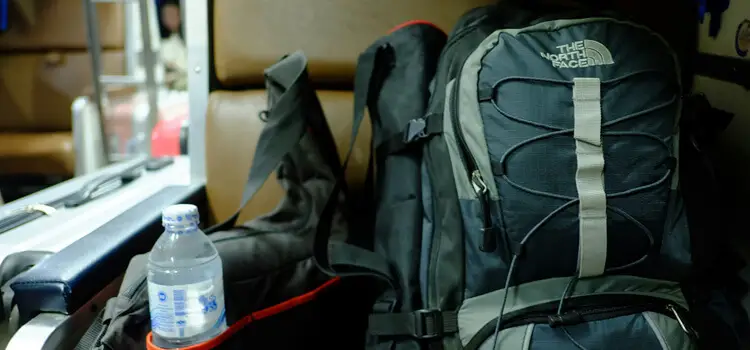As an Amazon Associate, I earn from qualifying purchases.

First, empty your rucksack completely. Next, hand wash it with mild soap, making sure to rinse any soap afterward. To promote faster drying, leave your backpack in a place with good airflow but not direct sunlight. Heading outdoors can be dirty work for your gear. When hiking on wildlife trails or national parks, your backpack will inevitably accumulate dirt, sweat, and grime buildup in a few weeks. How to clean a hiking backpack? while it may not seem important, cleaning your backpack is essential to keeping its material fresh while ensuring its safety and comfort . But having a clean rucksack isn’t just an aesthetic concern. Proper maintenance after a single outing will help reduce odor and, more significantly, prolong the use of your pack.
Choosing The Right Cleaning Supplies
You may also need these materials after a long hike to clean the various dirt on your bag. The proper cleaning materials will ensure quality cleaning while being non-harmful on the bag’s material. Therefore, I will take you through the best products to ensure your bag is spotless and smells fresh as you prepare for the next hike.
Consider The Material Of The Backpack
First, ensure they are appropriate for your bag’s materials. The following are some standard existing materials for a bag.
- Nylon: It is durable and easy to clean;
- Polyester: It resists weathering and abrasion;
- Canvas: It is sturdy but gentle cleaning products may be required;
Select Gentle Cleaning Products
Ensure you know the fabric type for your bag before selecting your cleaning product. It will ensure the best products avoid the bag’s damages. I can recommend mild soap with warm water as the best cleaning product for your bag to ensure quality cleaning. Ensure you do not use harsh chemicals that may damage your bag’s waterproof coatings and fabric.
| Type of Cleaner | Use Case |
| Non-Detergent Soap | Safe for most materials, preserves waterproofing |
| Mild Dishwashing Liquid | Effective on grease, gentle on fabrics |
| Baking Soda | Natural deodorizer for removing odors |
Preparing The Backpack For Cleaning
Preparation of the Backpack for Cleaning . Hiking is an amazing experience, but the aftermath can quickly make a marvelous time miserable if the hiking backpack is dirty or infested with bugs. Good preparation is the first step to clean the backpack sufficiently. This is a simple guide before giving it a good wash.
Emptying The Backpack
Once again, turn the backpack upside down and empty every pocket. Shake it to remove any loose dirt. Check if you have left something. Some items might be in the most unexpected places, like small pockets.
- Check all compartments;
- Open zippers and flaps;
- Find and remove items you might have left in hidden pouches;
Removing Detachable Parts
The nest step is to remove detachable parts like straps and hip belts . Most are attached with clips or Velco. Removing detachable parts gently.
| Detachable Part | Attachment Type |
| Rain Cover | Clip |
| Straps | Velcro |
| Hip Belt | Buckle |
Checking For Stains And Odor
Inspect the bad for marks and a smell. Now we are ready to clean the backpack. Some areas may be more prone to smell or leave marks.
- Spot treat stains;
- Make a note if there is any particular odor;
Hand Washing The Backpack
Cleaning your pack by hand not only refreshes it but is also one of the safest methods. Soak a backpack in soapy water is the best way to clear out the dirt without damaging the fabric or coatings. You need mild detergent, large basins or your tub, and a soft brush.
Submerging The Backpack In Soapy Water
Empty the backpack and shake it to get rid of debris. Remove any metal frames you can. Fill a basin with cool water and add some mild detergent. Immerse the backpack fully, and ensure pockets and folds in the fabric are exposed to it. Soak for up to one hour, but not more.
Scrubbing The Exterior With A Soft Brush
The day after, use a gentle brush to clean the hiking backpack exterior. Scrub its dirtiest parts, its pouch bottom and back. With your fingertips and/or an old toothbrush, clean the zippers and those other hard-to-reach areas. Do not scrub vigorously as this can damage whatever’s underneath the material.
- Drain the basin and refill it then submerge the backpack again;
- Squeeze the pockets and fabric to ensure the soap is out;
- Squeeze more water out and hang the pack upside down to air dry;
- Avoid direct sunlight as it can degrade the fabric; use a towel to pat the excess water;
Machine Washing The Backpack
After wearing your hiking backpack for clean the last time during a long hike, you can decide to give it a full wash. Out of three options of cleaning a backpack, this is probably the easiest. Simple steps for machine washing, Remove all your belongings. Check out the label.
Using A Delicate Or Hand Wash Cycle
Most backpacks are suitable for a delicate or hand wash cycle.
- Turn it inside out, if possible;
- Placed it in a laundry bag; this way, the straps won’t get tangled;

Adding Mild Detergent
Cleaning agents with lots of chemicals might be too harsh for the backpack fabric.
- Use non-bio detergent;
- Follow the manufacturer’s recommendation when pouring;
Opting For Cold Water
Here I recommend going with cold water as it is best for the fabric. It won’t cause shrinking and will keep the material intact.
| Water Temperature | Reason |
| Cold Water | Prevents damage. |
| Hot Water | Risk of shrinking and fading. |
Drying The Backpack
Cleaning your hiking backpack isn’t complete without proper drying. After washing the pack, the next step is drying the backpack cautiously to sustain its shape and material at most. Meaning, the following steps illustrate the best way to dry the backpack.
Air Drying The Backpack
The best way to dry your backpack is air drying. Thus, the following steps guide on air drying the pack:
- Gently shake off the excess water;
- Hang the backpack upside down;
- Keep all pockets and compartments open;
- Position in a well-ventilated but shaded area;
- Let the air do the remaining work;
Avoiding Direct Sunlight And Heat Sources
Equally, it is vital to know that direct sunlight and other heat sources can cause harm to the backpack. Hence, the following ways can prevent harm:
- Do not put the backpack under sunlight;
- Avoid radiators and heaters;
- Dispense a hair dryer or other heat devices;
- Extreme heat can twist fabrics and deplete coatings;
Reassembling The Backpack
Now that the hiking backpack is clean and dry, it is time to put everything back together. The process is vital in terms of preparing your backpack for a new adventure as follows.
Attaching Detachable Parts
Initially, lay out detachable parts in front of you.
- Clip buckles and reattachment of straps;
- Slide in the required rod frames;
- Attach the shoulder straps with the hip belt;
Ensuring Zippers And Straps Are In Place
Align all integrated zippers. Adjust all straps. As such, your backpack is reassembled and ready to go.
| Component | Check |
| Zippers | Zip and unzip each one. |
| Straps | Pull to check they’re secure. |
Storage And Maintenance Tips
Certainly, cleaning the hiking backpack is not the concluding part of the backpacks’ care. Storage and periodic maintenance guarantee the backpack is kept in outstanding condition for the following adventures. Thus, the following indications facilitate ensuring the backpack is durable and mold-free and prepared for any outdoor adventure.
Proper Storage To Prevent Mildew
Storage of the hiking backpack is an excellent way to prevent mildew and odors. A conducive place is cool and dry and is far from direct sunlight to deteriorate the fabric. Thus, the following steps can help store a backpack:
- Empty all pockets and spill out the remaining dirt;
- The backpack should be completely dry before storage;
- Hang the backpack upright to uphold shape and prevent creases;
- If there is a problem with the space, put in a breathable sleeve to prevent dust without trapping moisture;
Regular Inspection For Damage
A rapid inspection done after every adventure can save substantial time and effort in the long span. Therefore, the following list to inspect, Fix the sewing needle. Thus minor tears or parts repair once found, increase the longevity of the hiking backpack to use for trips to come.
| Part of Backpack | What to Check |
| Straps and Belts | Look for fraying edges and loose threads. |
| Zippers | Ensure they slide smoothly. Apply lubricant if necessary. |
| Seams | Check for tears or holes. |
| Buckles | Verify they click securely. |
| Fabric | Scan for abrasions or punctures. |
Final Tips For Backpack Maintenance
While the above points are measures to keep a hiking backpack in top shape, it is worth noting that regular maintenance is critical. However, below is a section detailing quick and effect spot treatment methods and backpack protection methods.

Spot Cleaning For Small Stains
Spot cleaning helps maintain the beauty of your pack. As such, small strains should be treated as soon as possible. Below are tips:
- Lightly dampen the area with water;
- Apply mild soap with a soft brush or cloth;
- Gently scrub the area;
- Rinse the area with clean water;
- Air the backpack to dry;
Using Waterproofing Sprays
Waterproofing sprays have the added benefit of keeping your backpack dry on the outside. Regular maintenance or using the best product ensures both the backpack’s water resistance and your gear. The perfect time to spray waterproofing sprays is after cleaning your backpack.
- Cleaning your backpack well;
- Ensure the bag is dry;
- Spray the waterproofing product evenly at the recommended distance;
- Let the spray settle and dry for optimal results;
Conclusion
Keeping your hiking backpack clean will ensure its durability and make every hiking adventure with you not to a health hazard. Take regular cleaning, maters and a few processes above will eliminate dirt or odor. Your bag is now ready for the next hike, and so are you. Get into the adventure with a clean companion.
Related Articles:
FAQs
Most hiking backpacks are not machine washable. Therefore, you should hand wash them according to the manufacturer’s label to ensure their integrity.
The first process would involve hand-washing, use cold water and mild detergent, and avoid submerging the pack, rinse completely and maintain an airtight drying place, not in direct sunlight. Avoid using a dryer.
First, empty the pack and remove any exquisite face reels, shake the five bags gently. Second, rinse lightly with mild detergent using soft brushes and rinse the pack thoroughly. The bag should be dried not in direct sunlight.
The procedure of cleaning involves the following; empty the bag and spray to remove debris. Use mild soap and a soft brush to clean the sweating areas. The bad should be rinses thoroughly and dried not under the sun.
As an Amazon Associate, I earn from qualifying purchases.
Leave a Reply